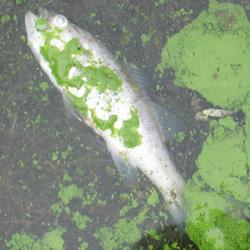Evaluating Linkages Between Algal Toxins and Human Health
Cyanobacterial Bloom on Lake Okeechoobee in 2016
The amino acid β-methylamino-L-alanine (BMAA) is produced by cyanobacteria and has been suggested by human health researchers as a causal factor for degenerative neurological diseases such as Amyotrophic Lateral Sclerosis (ALS), Parkinsonism, and dementia. An objective review concluded that this hypothesis is not supported by existing data.

Algae and cyanobacteria naturally produce toxins such as microcystins and saxitoxins that can kill wildlife and domestic animals and cause illness or death in humans through exposure to contaminated freshwater or by the consumption of contaminated drinking water, fish, or shellfish. The lethality of algal toxins was first noted in 1878 when livestock deaths associated with watering from an Australian lake during an algae bloom were observed. The discovery, in 2014, that the City of Toledo, Ohio, water supply was contaminated by microcystins drew national attention to the potential vulnerabilities of our water resources to toxins formed in association with harmful algal and cyanobacterial blooms. Scientists with the U.S. Geological Survey (USGS) research and monitor toxic algal and cyanobacterial blooms to protect the health of humans, pets, livestock, and wildlife, and the economic vitality of recreation in lakes.
Studies during the past 40 years have postulated that exposure to BMAA is related to several severe neurological diseases. This hypothesis first emerged due to associations between dietary exposures to BMAA and high incidence of Amyotrophic Lateral Sclerosis/Parkinsonism Dementia Complex (ALS/PDC) in Guam. The production of BMAA in common freshwater- and ocean-dwelling cyanobacteria has led to the formation of similar hypotheses associating consumption of contaminated seafood and exposure to water during cyanobacterial blooms with globally occurring incidences of ALS, Parkinsonism, and dementia. In this study, scientists went beyond existing compilations and summaries of previous scientific literature and critically evaluated these hypotheses and associated studies. Based on this rigorous evaluation, they concluded that a causal link between these diseases and exposure to BMAA is not supported by existing data.
The results of this study are particularly useful for resource managers and researchers trying to understand the relationship between environmental exposures to biogenic compounds and diseases in humans and wildlife.
This study was supported by the USGS Environmental Health Program (Toxic Substances Hydrology and Contaminant Biology), the U.S. Environmental Protection Agency, University of Illinois Urbana-Champaign, and Baylor University.
See below for related science.
Toxins and Harmful Algal Blooms Science Team
Satellite Data Used to Estimate and Rank Cyanobacterial Bloom Magnitude in Florida and Ohio Lakes—Developing Tools to Protect Human and Wildlife Health from Cyanotoxin Exposure
Mixtures of Algal Toxins Present Prior to and After Formation of Visible Algal Blooms—Science to Inform the Timing of Algal Toxin Exposure
Understanding Drivers of Cyanotoxin Production in the Lake Okeechobee Waterway
Understanding Associations between Mussel Productivity and Cyanotoxins in Lake Erie
New Method Developed to Quantify Spatial Extent of Cyanobacterial Blooms
Satellite Imagery Used to Measure Algal Bloom Frequency—Steps Toward Understanding Exposure Risk
Cyanobacteria from 2016 Lake Okeechobee Harmful Algal Bloom Photo-Documented
Cyanobacterial (Blue-Green Algal) Blooms: Tastes, Odors, and Toxins
The amino acid β-methylamino-L-alanine (BMAA) is produced by cyanobacteria and has been suggested by human health researchers as a causal factor for degenerative neurological diseases such as Amyotrophic Lateral Sclerosis (ALS), Parkinsonism, and dementia. An objective review concluded that this hypothesis is not supported by existing data.

Algae and cyanobacteria naturally produce toxins such as microcystins and saxitoxins that can kill wildlife and domestic animals and cause illness or death in humans through exposure to contaminated freshwater or by the consumption of contaminated drinking water, fish, or shellfish. The lethality of algal toxins was first noted in 1878 when livestock deaths associated with watering from an Australian lake during an algae bloom were observed. The discovery, in 2014, that the City of Toledo, Ohio, water supply was contaminated by microcystins drew national attention to the potential vulnerabilities of our water resources to toxins formed in association with harmful algal and cyanobacterial blooms. Scientists with the U.S. Geological Survey (USGS) research and monitor toxic algal and cyanobacterial blooms to protect the health of humans, pets, livestock, and wildlife, and the economic vitality of recreation in lakes.
Studies during the past 40 years have postulated that exposure to BMAA is related to several severe neurological diseases. This hypothesis first emerged due to associations between dietary exposures to BMAA and high incidence of Amyotrophic Lateral Sclerosis/Parkinsonism Dementia Complex (ALS/PDC) in Guam. The production of BMAA in common freshwater- and ocean-dwelling cyanobacteria has led to the formation of similar hypotheses associating consumption of contaminated seafood and exposure to water during cyanobacterial blooms with globally occurring incidences of ALS, Parkinsonism, and dementia. In this study, scientists went beyond existing compilations and summaries of previous scientific literature and critically evaluated these hypotheses and associated studies. Based on this rigorous evaluation, they concluded that a causal link between these diseases and exposure to BMAA is not supported by existing data.
The results of this study are particularly useful for resource managers and researchers trying to understand the relationship between environmental exposures to biogenic compounds and diseases in humans and wildlife.
This study was supported by the USGS Environmental Health Program (Toxic Substances Hydrology and Contaminant Biology), the U.S. Environmental Protection Agency, University of Illinois Urbana-Champaign, and Baylor University.
See below for related science.










